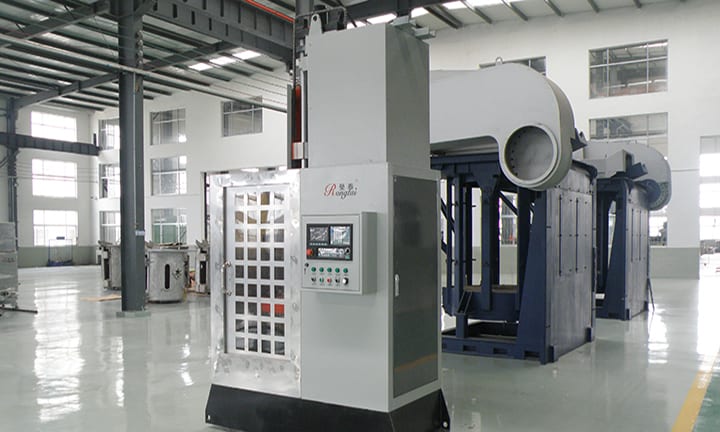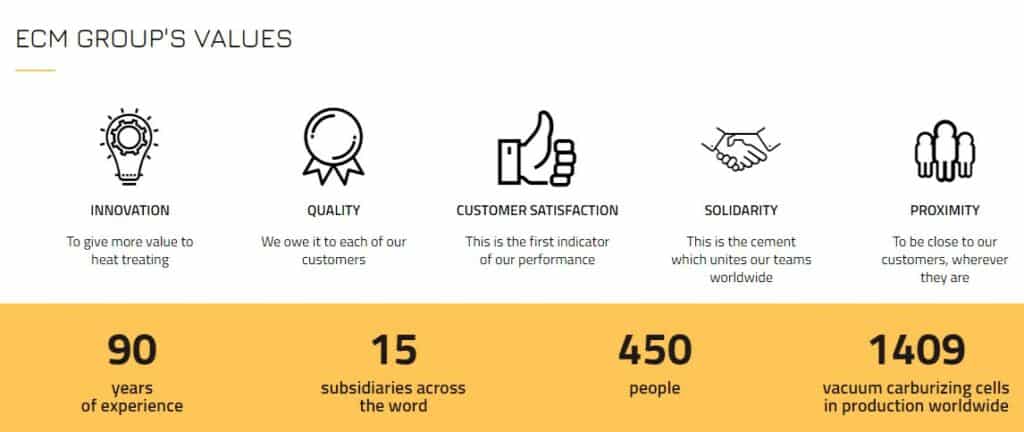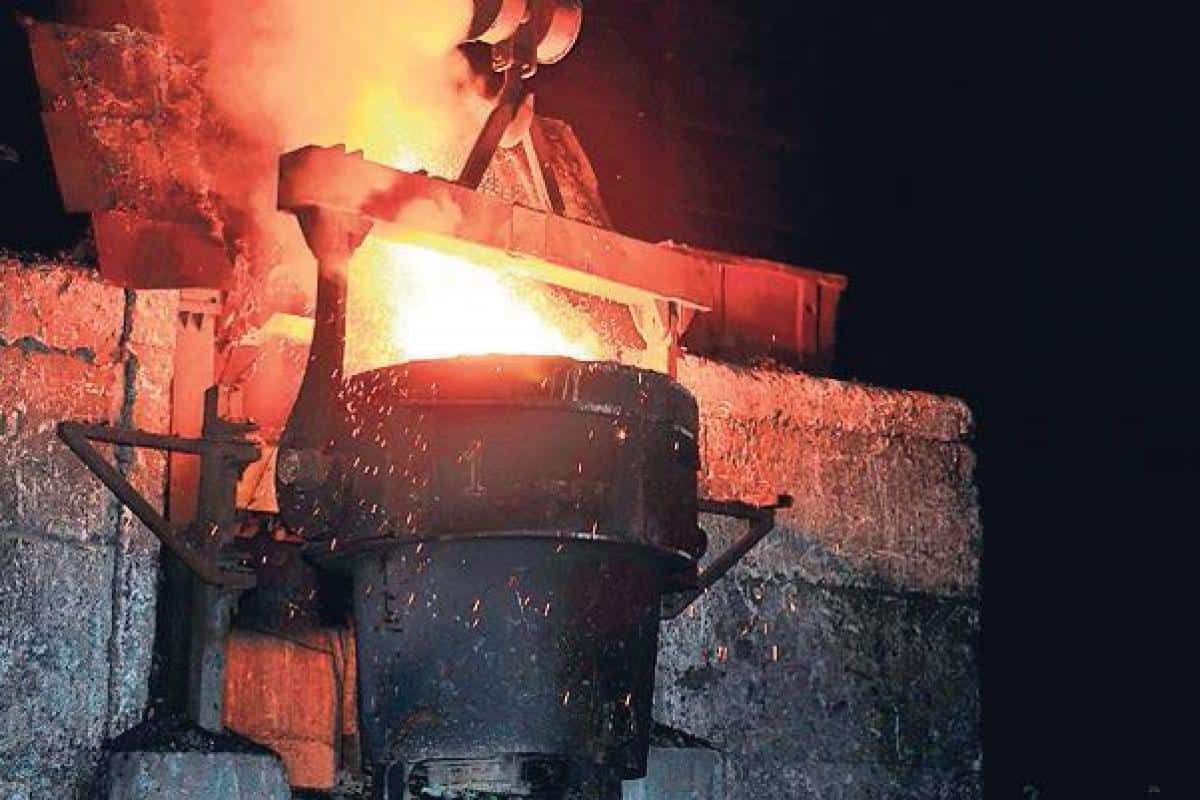Conventional methods of metal melting usually involve burning fuel that pollutes the environment and makes it difficult to control the temperature. Knowing how to find the best induction furnace will provide you with a clean and energy-efficient way of melting different types of metal.
You should bear in mind that these machines have maximum operating temperatures optimized for a particular type of metal, so you can’t use the same induction furnace to melt copper and platinum.
That’s why knowing the properties of metals you’ll be working with is perhaps the most important step in the process of finding an appropriate unit for your foundry. So, in this guide, we’re going to help you find the best induction furnace that will enable you to melt, cast or smelt different types of metals.
Go through our guide to furnace types you can use to heat your home.
Understanding how an induction furnace works
Being familiar with the operating principles of induction furnaces will make it easier to choose a optimized model for the type of work you’re doing in your foundry. These machines utilize electricity to generate heat and create electromagnetic induction within the heated object.
The metal is stored in a crucible encircled by a copper wire that generates a magnetic field using a powerful alternating current. Such setup produces a reversing rapidly magnetic field and produces the eddy current which enters the metal.
This current heats the metal to its melting point and continues to stir it once it reaches the fluid state. An induction furnace can also utilize the concept of magnetic hysteresis to heat ferromagnetic materials by reversing the molecular magnetic diploes.
Shifting magnetic forces within the furnace generates a humming noise that helps the machine operator determine any melting process disturbances.
Types of induction furnaces
Induction melting furnaces have become a standard piece of equipment for foundries over the course of the 20th century.
There are two common types of these furnaces that operate on different principles. Consequently, they’re not equally energy efficient, so the amount of power you’ll have to use to run an induction furnace depends on the type you choose.
Core or channel furnaces

Originally designed to melt brass, today, the channel furnaces are used to melt various materials such as copper, iron, aluminum, or zinc. A short-circuited iron core transformer surrounded by a primary coil generates the heat that melts the metal.
An alternating current passes through the primary coil and induces the secondary coil that generates the heat. Thus, almost no power is lost between the two coils, which makes channel furnaces highly energy-efficient.
This type of induction furnace is commonly used in foundries with high production volumes as they can provide vast quantities of molten metal that remains ready to use for an entire week.
Coreless induction furnaces
Instead of a core, these furnaces have a refractory lining or a crucible encircled by a coil that heats it. The winding transfers the heat directly onto the crucible or lining, which is why these units have a 75% power efficiency.
They are more versatile than channel induction furnaces, as you can use them to melt all types of metal. However, frequent heating and cooling of refractory linings can cause them to deteriorate quickly, but replacing this component of a coreless induction furnace isn’t too expensive.
Size and frequency of induction furnaces

As a general rule of thumb, small furnaces function best at high frequencies, and large furnaces work best at low furnaces. The frequency range of induction furnaces spans from 50Hz up to 1000 kHz, depending on the model.
Failing to adjust the frequency to the material you’re working with can result in slag and contaminating particles in the melt. Furthermore, inadequate frequencies can cause gas build-up that makes the casting process less efficient.
Using an induction furnace at a frequency that is too high for the material you’re melting can make it impossible to produce a homogenous melt, as the unit might not heat or stir the melt evenly.
The capacities of these machines vary from less than one pound to more than 100 tons, which enables you to choose the size that best matches your production needs.
Go through our guide to water heater systems to learn more about different methods you can use to hear water in your home, workshop, or foundry.
Operating temperatures
Induction furnaces have maximum temperatures optimized for different types of metal, so a unit capable of melting carbon steel must produce temperatures between 2600F and 2800F.
On the other hand, a copper induction furnace generates temperatures up to 2000F, and you can only use it to work with metals with melting points below 2000F.
These machines allow for precise temperature adjustments so that you can set the frequency and temperature that is best suited for the material you’re melting. For example, you can increase the current temperature by 100F in less than two minutes with a low risk of significant carbon pickup.
The amount of time required to create a melt that is ready to use depends on the material, but in most cases, the melting process should be completed in less than thirty minutes, unless you’re working with loads that are larger than 4.000lbs.
It is advisable to get in touch with the unit’s manufacturer if you want the melting process to last longer than one hour.
The best induction furnace suppliers
Getting a used induction furnace is risky because you have no way of knowing the state the machine is in or how long its components will last before you have to replace them.
That’s why your best option is to obtain an induction furnace directly from the supplier that will tailor the machine in accordance with your production needs. So, let’s take a look at some of the best induction furnace suppliers in the United States.
Noble Industrial Furnace Company

Specialized in industrial furnace design, the Noble Industrial Furnace Company manufactures a wide range of thermal processing equipment. Besides induction furnaces, the brand also produces pit, belt, or box furnaces and a variety of other units designed for use in industrial settings.
In addition, the company offers refurbishing services as they redesign and restore old induction furnaces per your specifications.
The Grieve Corporation
For more than half a century, the Grieve Corporation has been one of the industry-leading producers of melting furnaces. The company customizes the unit to fit the size of your foundry and adjusts the features of an induction furnace to your requirements.
ECM Technologies Group

As one of the largest producers of melting furnaces globally, the ECM Technologies Group is one of the most reliable options for businesses in need of a durable and power-efficient induction furnace.
The brand’s models can be used for various purposes, including melting, purification, or atomization of metals.
The most important factors to consider while choosing an induction furnace
An induction furnace is a durable piece of equipment that has to be adjusted to your production needs and your workspace. Their components can be very expensive, so even a minor repair can cost you hundreds if not thousands of dollars.
Hence, you need to ensure that the unit’s refractory lining can withstand frequent temperature changes if you don’t want to batch melt the materials and keep the furnace running for days.
Also, you should keep in mind that the installation process of these units can take place in several stages, and each stage requires a significant amount of time. Here are some of the most important factors you need to consider while choosing an induction furnace
The type of metal you’re working with
Knowing the melting points of all metals you’d like to melt in your foundry will help you find a unit capable of generating the temperatures required to melt a particular material. For example, the maximum operating temperature of an induction furnace can range from just 212F to 5432F, depending on the model.
Besides the temperature, you should also pay attention to the unit’s frequency spectrum that determines how efficient the machine is at stirring the melt or preventing different types of particles from contaminating it.
The accessibility of spare parts
Ideally, you should get an induction furnace directly from the supplier responsible for the repairs of the machine during the warranty period.
Obtaining a unit from a reliable source will also make it easier to find spare parts since you can contact the supplier and inquire about the availability of spare parts for a particular model. By doing so, you’ll minimize the amount of time you’ll have to spend on servicing the machine and avoid losing clients.
The unit’s melting potential

Estimate how much metal you want to melt on a weekly level before starting to search for a new induction furnace. This will help you work out the unit’s size, as some models can’t hold more than 1lbs of metal while others can melt thousands of pounds of metal at once.
You should also find out which type of scrap you can use as alloys, how much metal loss the unit produces, or how frequently you have to perform analysis controls.
Foundry size and work area
Induction furnaces can occupy vast amounts of space, so you first have to check its dimensions before you choose a model. Some suppliers manufacture custom-made machines that are adjusted to the foundry’s space limitations.
Custom-made models make it easier to create a spacious work area around the furnace and perform different metal casting tasks. If you would like to refurbish an old induction furnace, you must first make sure that it can fit in your foundry.
Operating costs
The costs of using an induction furnace aren’t limited to the power required to keep the unit running, as the materials and servicing add to the machine’s operating costs.
The amount of electricity the machine will use on a monthly level depends on its size, the quantities of metal you want to melt, and the frequency at which you’re using the unit.
Most models need between 500kW and 800kW per hour to melt a ton of metal, making them more energy-efficient than other types of metal melting machines.
The advantages of induction furnaces
Simple temperature adjustments

All types of induction furnaces can melt metals quickly because they develop a chosen temperature within minutes. What’s more, these machines allow you to fine-tune the temperature at which you’re melting a material without producing side effects that can affect the quality of the cast.
Durable construction
A well-built induction furnace can last for decades, enabling you to build your business around a single machine. In addition, trustworthy suppliers offer maintenance services that reduce the chances of significant part failures that take weeks to repair.
Excellent energy efficiency
Despite high power consumption, these machines are more energy-efficient than any other unit used to melt metals. Both channel and coreless induction furnaces minimize the energy loss and ensure that a minimum amount of power is used to heat the core or the crucible to the desired temperature.
The disadvantages of induction furnaces
Complicated installation process
You have to go through several stages to get an industrial induction furnace up and running. Licensed technicians must first install the machine’s body and then its water purification system. Afterward, the hydraulic system is installed, and then finally, the unit’s setup is completed by installing the electrical system.
The best alternatives to induction furnaces
Depending on the materials you’d like to work with, you can choose from various melting devices. It is important to choose the unit that can develop temperatures sufficient to melt a particular type of metal.
The size and melting capacities of these appliances vary, and you must learn more about them before deciding to use them in your foundry. We’ve selected a few of the best alternatives to induction furnaces, so let’s take a look at what they have to offer.
Cupola furnace

Even though it is one of the oldest types of metal melting devices, cupola furnaces are still used in foundries around the globe. They’re commonly utilized to melt cast iron and Ni-resist iron, although some units can also melt different types of bronze.
To initiate the so-called cupola campaign, you have to ignite the coke the device uses as fuel. Afterward, you should gradually introduce air or flammable gases to increase the temperature inside the furnace.
Once the coke reaches the optimum temperature, a solid piece of iron is inserted into the device through an opening at the top. After the level of molten iron or bronze in the unit’s well raises above a certain level, the melt is poured into the cast through the cupola’s tap hole.
Arc furnace
Electric arc furnaces can melt between one and 400 tons of metal simultaneously, and they’re a standard piece of equipment in industrial foundries and steel mills. Unlike induction furnaces, these machines expose the material to the electric arc so that the currents can go directly through it.
The process of charging these furnaces can be dangerous if the scrap is added into molten metal since, due to their size, vast amounts of light and heavy gauge metals have to be thrown into the furnace.
These devices are a poor fit for small, privately owned foundries because of their size and high upkeep requirements.
Blast furnace
Named after a sound produced by the combustion air when it is introduced into the machine, blast furnaces are utilized to produce pig iron, lead, and copper. In addition, insulation materials like stone or rock wool can also be produced with these furnaces.
These machines rely on chemical reactions between ore, coke, or limestone and combustion gases to generate melting temperature.
These systems are too large and too complex for installation in indoor spaces, as they demand a constant supply of fuel and supporting structures that boost their efficiency. Go through our guide to residential insulation for more information about materials you can use to insulate your home.
Frequently asked questions about induction furnaces.
Question: Can I use an induction furnace in my workshop?
Answer: Yes, you can. Models like the KUNHEWUHUA high-frequency induction furnace enable you to melt gold, copper, or silver in your home-based workshop.
Question: How much do induction furnaces cost?
Answer: Units that have melting capacities limited to a few pounds can cost a few thousand dollars, while models designed for production at an industrial level usually cost more than $10,000.
Question: Which types of scrap can I add to an induction furnace?
Answer: The scrap types you can charge into an induction furnace depend on the model, and you must check the manufacturer’s instructions to find which scrap types you can use.
Question: Do induction furnaces require constant water flow?
Answer: Yes, they do. These furnaces depend on a constant water supply for cooling, and they use approximately a gallon of water per 25kW.
Final thoughts: Deciding which induction furnace to get?
Although they’re predominantly used in industrial settings, some induction furnace models enable you to melt metals in your home-based workshop. However, the materials you can work with largely depend on the maximum temperature a unit can develop.
So, if you get a furnace with a maximum temperature of 3.000F, you’ll be able to melt most types of metals. On the other hand, models that operate at temperatures around 1000F can melt copper, gold, and other materials with relatively low melting points.
We hope this guide to the best induction furnaces has provided you with the information you needed to find the unit that fits your needs. Leave a comment and let us know, or continue reading our guide to fireplace systems or the best kinds of furnace cement.
- R13 vs R15 Insulation Compared: What’s the Difference? - December 9, 2023
- Ruud vs Trane HVAC Systems Compared - December 9, 2023
- Senville Mini Split Review and Guide: Is It Worth Buying? - December 9, 2023

